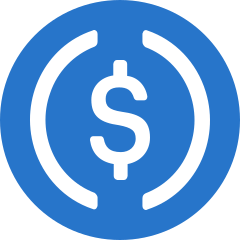
USDC
0.08%
24H Price
About USDC
The USDC price is $1.00, a change of 0.08% over the past 24 hours as of 1:50 a.m. The recent price action in USDC left the tokens market capitalization at $34.00B. So far this year, USDC has a change of -0.07%. USDC is classified as a Stablecoin under CoinDesks Digital Asset Classification Standard (DACS).
USD coin (USDC) is an Ethereum-based stablecoin – a type of digital asset whose value is pegged 1:1 with the U.S. dollar. That means holders can redeem 1 USD coin for $1 at any time. Every USDC is backed by one dollar or an asset with an equivalent value, held in accounts with U.S. regulated financial institutions.
USDC price
Launched in late 2018, USDC is designed to maintain a stable value unlike other typically volatile cryptocurrencies. But even stablecoins such as USDC can still be prone to mild changes in price.
USDC’s price spiked to an all-time high of $1.19 in May 2019, and noted an all-time low of $0.891848 in May 2021. Changes to supply and demand is the main reason stablecoins move off their $1 peg. During bullish market cycles, demand for stable value assets like USDC drops. That causes the price of USDC and other U.S. dollar-backed stablecoins to fall beneath one dollar. Overall, though, USD coin has maintained long periods of stability at $1.
There is no maximum or total supply of USD coin, as new tokens are issued based on demand.
When a user redeems USDC for $1, the team burns (permanently removes) the appropriate amount of USD coin from circulation, and funds from underlying reserves are transferred to the client’s external bank.
How does USD coin work?
USD coin serves to tokenize U.S.dollars on a blockchain. The service is a collaboration between crypto exchange Coinbase and financial services provider Circle. Their shared vision to bring U.S. dollars onto a blockchain means traders can preserve their portfolio’s dollar value during periods of high volatility without having to exchange their crypto assets for a fiat currency. It also allows for tokenized dollars to be sent across a blockchain network – something that’s much faster and cheaper than sending dollars through the legacy banking system.
USD coin can be generated only by sending USD to the token issuer’s bank account and interacting with the smart contract on the blockchain one wants to use. To redeem USDC for USD, the process is reversed.
USDC is found on multiple public blockchains, including Ethereum, Solana, Algorand, Stellar, Tron and Hedera. The token is interoperable with all features on the public blockchains it resides on, including decentralized finance (DeFi) and smart contracts.
Key events and management
USD coin was developed by the Centre Consortium, a company that represents the partnership between Circle and Coinbase. Centre develops the technology and governing framework of USD coin, and Circle and Coinbase issue the coin.
Centre was founded in 2017 by Wall Street veteran David Puth, who was still the CEO as of November 2021. The company raised $20 million during an initial funding round in December 2017 and another $20 million through a November 2018 venture round led by Digital Finance Group, according to Crunchbase.
USD coin is available on the Optimism layer 2 scaling product for the Ethereum network. Because the project is open to collaboration, Centre and USDC issuers may explore other layer 2 opportunities in the future.
As crypto voters defect from the Democratic Party to support Trump, Rep Read more...
Crypto Sectors
Sectors
USDC (USDC)

USDC

- AssetsWeight24H%
Bitcoin Calculator
CoinDesk’s Bitcoin and Cryptocurrency Calculator determines the exchange rates between major fiat currencies and cryptocurrencies – including BTC, BCH, ETH and XRP to USD, EUR, GBP, IDR and NGN – with up to six decimal places of accuracy. Conversion rates are based on CoinDesk’s Bitcoin Price Index and the price indices of other digital assets. World currency prices are based on rates obtained via Open Exchange Rates.
Research Reports
Diving in deeper on cryptocurrency.


:format(jpg)/cloudfront-us-east-1.images.arcpublishing.com/coindesk/SWPGSD2NDVHKDHCUUFCLUIOZ54.png)
:format(jpg)/cloudfront-us-east-1.images.arcpublishing.com/coindesk/ZDC3FRMKDBCHDMRLSDPLCIVTUE.jpg)
:format(jpg)/cloudfront-us-east-1.images.arcpublishing.com/coindesk/C22KBA3O6FG5RM3JTN56ZN75BM.jpg)